|
A brief
monograph of the City of Arad
The
city of Arad is located in the plain, near the banks of the
river Mures, at about 100 km east of the Tisa River. The relatively
mild weather, the rich fauna and flora constitute an optimal
environment for human inhabitancy.
Historical
Evolution until the XIth Century
The
first traces left by human presence are about 40000 years
old. A hunting expedition of a group of Homo sapiens, coming
from the Zarand Mountains, may be credited for them. Only
the end of the Vth millennium BC founded the first stable
settlement. The villagers that occupied the northern bank
of the river were farmers. During the IVth millennium BC the
settlement expanded to the southern bank. These communities
were part of the pre-indo-European civilisation.
During
the second half of the IIIrd millennium BC both riverbanks
as well as the islands were occupied by prosperous villages.
These belonged to the Indo-European civilisation of the Bronze
Age, which reached its evolution peak around the year 1000
BC. Violent events, certified by archaeological discoveries
made in the very heart of the modern city,(burned dwellings,
the bronze deposit from "Astoria"), have set an
end to these settlements.
Dacian
settlements took shape on both riverbanks during the first
half of the Ist millennium BC. In the Vth century a group
of Scythians quartered nearby but was subsequently assimilated.
The Mures valley was one the major gateways for che Celtic
invasion towards Transylvania. On the verge of the IVth and
IlIrd century BC Celts stroke root on both sides of the river,
nearby the Dacian settlements. Their coexistence, not peacefull
at all times, lasted for almost two centuries. In the end,the
Dacian majority assimilated the Celts.
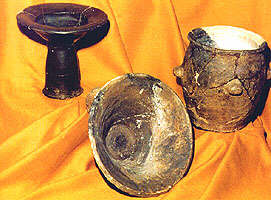 The Dacian settlement
located it the southern limit of Micalaca was shattered by
the Roman troops in 101-102. During the second Dacian War
(105 - 106) Traian conquered the territory north of the Mures
(including Crisana) making it part of the province Dacia.Within
the limits of Aradul Nou the Roman army built a fort that
hosted a vexilatio of the legio IIII Flavia Felix.Hadrian
(117-138) withdrew the border of Dacia to the East and left
the lower course of the Mures to the Sarmatians and the free
Dacians. Roman troops though continued guarding the military
and commercial road along the Mures, a road that linked the
provinces Dacia and Pannonia. The Dacian settlement
located it the southern limit of Micalaca was shattered by
the Roman troops in 101-102. During the second Dacian War
(105 - 106) Traian conquered the territory north of the Mures
(including Crisana) making it part of the province Dacia.Within
the limits of Aradul Nou the Roman army built a fort that
hosted a vexilatio of the legio IIII Flavia Felix.Hadrian
(117-138) withdrew the border of Dacia to the East and left
the lower course of the Mures to the Sarmatians and the free
Dacians. Roman troops though continued guarding the military
and commercial road along the Mures, a road that linked the
provinces Dacia and Pannonia.
Through
the IInd to the IVth century some Dacian and Sarmatian settlements
were located on the territory of today's Arad. These had intense
trade relations with the Roman world. During the major crises
that struck the Empire by the mid IIIrd century inhabitants
of the province emigrated into the barbarian world where they
grounded senttlements such as the one discovered at Ceala,
Horia or Vladimirescu-"Padurea vrabiilor" which
were housed by potters. After the Romans withdrew from Dacia
the communities living in the area of Arad maintained their
relations to the Roman provinces situated to the right of
the Danube despite of all the Goths, Huns, Gepidae and Avars
that passed through these places briefly dominating them.
The earliest remains of the Slav presence along the lower
Mures are dated to the late VIth century. The assimilation
of the Slav element by che Romanic population (proto-Romanians)
is considered to be the final stage in the moulding of the
Romanian people.
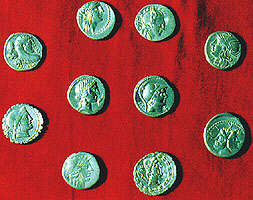 The settlements dated
to the second half of the Ist millennium were concentrated
on the northern bank of the Mures. Among these the one from
Vladimirescu - "Schanzen", dated to the VIIIth -
IXth century, has been archaeological examined. The settlements dated
to the second half of the Ist millennium were concentrated
on the northern bank of the Mures. Among these the one from
Vladimirescu - "Schanzen", dated to the VIIIth -
IXth century, has been archaeological examined.
During
the Xth century the Hungarians started their expansion towards
Transylvania one of their major penetration ways being the
Mures valley. This historical moment is confirmed archaeological
by the grave of a Hungarian warrior unearthed at Ceala. Confronted
with the Hungarian peril, Romanians, subordinated to the principality
of Glad, built an earthfort at Vladimirescu -"Schanzen".The
Hungarian warriors devastated this at the middle of the Xth
century. Rebuilt under the authority of the voivode Ahtum,
the fortress has been completely destroyed in 1028 by another
Hungarian military expedition.
The Medieval
Arad
The
archaeological finds certify the existence of several villages
in the area of the actual town and its vicinities starting
with the XIth century. Since the same period respectively
the years 1080 - 1090, dates the first written mention of
the toponym Orod. All that remained from the old ecclesiastic
and county residence are the ruins of the cathedral in Vladimirescu,
indicating the position of veterum Orod(old Arad). Starting
with the XVth century documents mention Arad as civitas or
oppidum. Historians disagree upon the possible relation between
the old Orod, situated in Vladimirescu, and the later mentioned
Arad, located in the strict area of the modern city. Some
believe they are completely different settlements whilst others
presume that in the XIVth the old Orod was displaced to the
actual location of the city, more exactly to the area of today's
Dragasani district. Further research is expected to solve
the dilemma.
In
1514 the inhabitants of Arad, mainly serfs, joined the rebel
army of Gh. Doja. The nobility repressed the uprising and
the peasants became subject to a cruel revenge. A new rebellion
broke out in 1526 followed by another bloodshed.
After
the disaster from Mohacs (1526), Ioan Zapolya, the elected
King of Hungary, established his reign over Arad too.
While
the Turks created the pashalik of Buda (1541), Transylvania
became an autonomous principality that included the Arad region
too.
In
1552 the Otoman troops conquered the town producing great
damage. The territory of the former county has been divided
into three units (sanjaks), the one relative to Arad including
the town and 113 villages. Between 1553 and 1555 the Turks
built a square brick fort, on the right side of the Mures,
close to the actual Traian Bridge. The censii from 1567 and
1579, ordered by the Sultan, register for Arad and the neighbouring
localities a number of 297 families, mainly farmers.
Transylvanian
troops liberated the inferior valley of the Murey in 1595
reintegrating Arad into the Transylvanian Principality. After
the victory from Selimbar (1599) the territory of Arad got
under the authority of Michael the Brave. Subsequent to his
death Gabriel Bethlen gave the fortresses on the Mures (including
Arad) back to the Turks keeping Ineu instead.
The Town
of the Modern Age
After
the failure of the Ottoman siege on Vienna (1683), the Imperial
troops started a huge offensive towards East, reaching and
conquering Arad in 1687. Two years later Eugene of Savoy had
already drawn the plans to rebuild the old Turkish fortress.
Georg Haruckern was appointed to direct the works. Following
the Austrian army, the first German craftsmen and merchants
arrived in Arad. The Karlowitz Peace (1699) set the border
between the Austrian and the Ottoman Empire on the Mures.
Arad became the centre of the Austrian frontier guard zone.
Therefore in august 1699 the first frontier guard troops,
recruited mainly among Serbs, where quartered in the town.
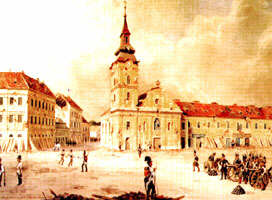 In 1702 Arad has
been promoted to the rank of a chamber town, a status that
conferred some economic facilities. The attack of the Kurutzy
(anti-Habsburg rebels), in the summer of 1707, left deep traces
in the town life, many buildings being destroyed. In 1702 Arad has
been promoted to the rank of a chamber town, a status that
conferred some economic facilities. The attack of the Kurutzy
(anti-Habsburg rebels), in the summer of 1707, left deep traces
in the town life, many buildings being destroyed.
Following
the victories of Eugene of Savoy the Habsburg domination was
instated in the Banat also, a situation confirmed by the Passarowitz
Peace (1718). As a part of the economic development plan for
the new conquered regions the Imperial authorities settled
German colonists, among these some dozens of families from
Franconia were brought to Aradul Nou (1724). Romanians and
Serbs inhabited the other surrounding villages. The town population
clustered around the fortress consisted of frontier guards
and civilians (peasants, craftsmen and merchants), Romanians,
Serbs, Germans and Hungarians. The number of inhabitants registered
in the town and its vicinities reached 441 families in 1720.
From
the administrative point of view, Arad and its subordinate
area had an intricate evolution. The Habsburg rulers first
included Arad and Zarand counties in Hungary. In 1732 almost
the whole county of Arad has been to duke Rinaldo di Modena
who eight years later lost both, the Impetial favour and the
domain. Arad County became state property (Aerarial domain)
and the town gained new economic facilities. The frontier
guard has been dismissed in 1746 and most of the Serbs, former
guardians, left for Russia. In the same year Arad was assigned
the centre of the new organised Nobility County.
During
the reign of Maria Theresa (1740 - 1780) the town developed
in almost all aspects. The population grew to 1321 families
in 1752. The weight of handicraft increased in economy. The
number of craftsmen grew from 90, in 1746, to 299, in 1774.
They gathered in guilds and acquired privileges from the authorities.
The first officially registered guild was the one of the German
furriers (1702). Until 1845, only in the town, 44 guilds including
65 different trades have registered. The workshops processed
mainly raw materials provided by the "agricultural sector"
of the town, still dominant in the XVIIIth century.
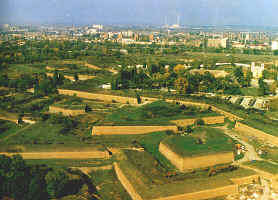 The construction
of the new fortress, located on the south bank of the Mures,
marked the history of the town deeply. A team of military
engineers directed by Ferdinand Philipp Harsch has designed
the Vauban-Tenaille style fortress. The works lasted over
20 years (1763 - 1783) and were carried out by thousands of
serfs. The construction
of the new fortress, located on the south bank of the Mures,
marked the history of the town deeply. A team of military
engineers directed by Ferdinand Philipp Harsch has designed
the Vauban-Tenaille style fortress. The works lasted over
20 years (1763 - 1783) and were carried out by thousands of
serfs.
The
fortress has a history of its own. The permanent garrison
consisted of the Infantry Regiment 33, participant at all
major military actions of the Empire. In the centre of the
Fortress there is a Catholic Church and in buildings around
it Franciscan monks were hosted. Until 1918, the fort also
was one of the largest military prisons of the Empire.
During
the revolution in 1848/49 the fortress played a crucial role.
Under siege of the Hungarian republican army, the garrison
bombed the town every day for nine months. In the summer of
1849 the Hungarian revolutionary army succeeded to occupy
the fortress for 46 days, before it was encircled by the Russian
and Austrian armies and forced to surrender. The Habsburg
troops used it once more as a prison and incarcerated 500
officers of the revolutionary army, the majority of them sentenced
to death. Among the executed were the 13 generals of the revolutionary
army who were hanged respectively shot on October 6th 1849
in the outer pill boxes. In 1752 the emperor Franz Joseph
I visited the fortress himself and lessened the sentences
of the imprisoned officers.
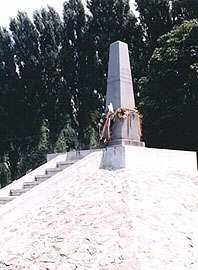 In the next decades the Arad fortress was a prison for
many war prisoners. Between 1914 and 1918 a camp has been
improved in the outer pillboxes hosting civilian and military
prisoners from Bosnia- Herzegovina. In the next decades the Arad fortress was a prison for
many war prisoners. Between 1914 and 1918 a camp has been
improved in the outer pillboxes hosting civilian and military
prisoners from Bosnia- Herzegovina.
In
November 1918 the fortress has been occupied by French-Serb
troops and in July 1919 the Romanian army took it over.
The
inhabitants of Arad tried since the XVIIIth century to obtain
the status of a free royal town, but only in 1826 succeeded
to ransom its privileges. In 1834 the emperor Francis I handed
over to the local authorities the diploma certifying this
title.
The
new condition created an optimal environment for further economic
development. First, the number of merchants increased up to
686 in 1870. The industrial activity remained relatively modest
in the first half of the XIXth century. In 1825 a machine-tools
factory functioned and in 1836 Anton Dangl started a factory
producing organs, the only one in the eastern part of Europe.
Most of the products were still manufactured in workshops.
Only
in the second half of the XIXth century the wind of change
was to be felt. The first step towards great industry was
the opening of the alcohol and yeast factory by the Neumann
brothers, 1851. The official statistics recorded for the years
1869 - 1870 a number of 5074 entrepreneurs, 6839 clerks and
11913 workers. Meantime, 2645 city inhabitants were farmers.
At
the end of the XIXth century and the beginning of the XXth
the industrial output got more diversified. In 1872 the machine
factory "Hendl" was set up, a cement and a brickyard
followed. The Lengyel brothers founded a furniture factory
in 1891 and next year the wagon Factory of Johann Weitzer
started production that at the beginning of the next century
was enlarged including cars, utility vans and planes. In 1909
the local industry enriched with a textile plant, property
of the Neumann family.
By
the beginning of the XXth century Arad was a major industrial
metropolis with 25 factories and 7 banks.
The
industrial growth stimulated the expansion of the city to
the North and West detrimental to agricultural districts.
The rapid pace of urban life requested a public transport
system, so in 1878 the first horse-trams were put in use,
linking the railway station to the main points of public interest
in the city. At the beginning of the XXth century the first
urban bus lines got into operation. In the last decade of
the XIXth century the water supply and sewage utilities were
completed. Public lighting based on oil lamps has been introduced
in 1828, gas lamps in 1860 and electricity in 1895.
Until
1747 the administration of Arad was divided between two mayoralties
- the Serb and the German. Afterward the mayor was assigned,
depending on the political juncture, among the Germans, Hungarians,
Jews and Romanians. In 1871 Arad became municipality so justice
and administration separated. After the dual Austro-Hungarian
regime settled (1867) the local authorities were dominated
by Hungarians and Jews.
Demographically
the evolution during the XIXth century was spectacular. In
l804 Arad had 8476 inhabitants, in 1850 there were 22398 and
in 1900 the number rose to 56260.
The
main political trends, conservative and liberal, appeared
in Arad in the first half of the XIXth century, represented
by discussion clubs. Concomitantly the national emancipation
movement of the Romanians took shape, mainly in the position
of clergy.
The
48 revolution gave an impulse to the political association,
materialised in the political parties founded in the last
quarter of the XIXth century.
The
Hungarian parties were the conservative (governmental) and
the "independence party". The conservatives kept
power accepting several compromises, not the universal and
secret vote though.
The
Romanian emancipation movement evolved into Romanian National
Party, founded in 1881.
The
socialist views had numerous followers, consequently, in 1894,
the founding congress of the Social-Democratic Labour Party
(Marxist) was held in Arad.
Due
to the Hungarian parties' reluctance to democratic changes
in society, the national and the socialist movements approached.
Arad was a multiethnic city, with a great number of labourers
and a solid tradition in the non-Hungarian nationalities struggle
for emancipation so the Nationalities Club of Deputies from
the Budapest Parliament and the Romanian section of the Social-Democratic
Party from Hungary established here.
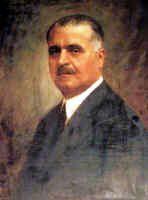 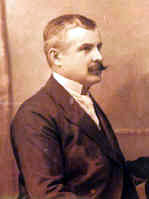 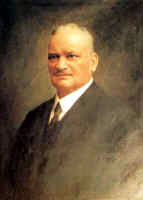 World
War I exposed both social and national strains in the Empire.
The Romanian National Party and the Romanian section of the
Social-Democratic Party from Hungary lead the Romanians' movement
for rights. On 30 October 1918, the Romanian National Council
was constituted and moved on 8 November from Budapest to Arad.
The leaders of this organisation were politicians from Arad:
Stefan Cicio Pop, Vasile Goldis, Ioan Suciu and Ioan Flueras.
A Hungarian delegation, lead by Oszkar Jaszi, came to Arad
to negotiate with the representatives of the Romanians. After
three days of discussions, 13th - 15th November, marked by
the opening to concessions of the Hungarian part, the decision
of the Romanians stayed firm: separation from Hungary and
union with Romania. The Central Romanian National Council
from Arad prepared the plebiscitary assembly from Alba Iulia,
which proclaimed, on 1 December 1918 the union of Transylvania
with Romania. World
War I exposed both social and national strains in the Empire.
The Romanian National Party and the Romanian section of the
Social-Democratic Party from Hungary lead the Romanians' movement
for rights. On 30 October 1918, the Romanian National Council
was constituted and moved on 8 November from Budapest to Arad.
The leaders of this organisation were politicians from Arad:
Stefan Cicio Pop, Vasile Goldis, Ioan Suciu and Ioan Flueras.
A Hungarian delegation, lead by Oszkar Jaszi, came to Arad
to negotiate with the representatives of the Romanians. After
three days of discussions, 13th - 15th November, marked by
the opening to concessions of the Hungarian part, the decision
of the Romanians stayed firm: separation from Hungary and
union with Romania. The Central Romanian National Council
from Arad prepared the plebiscitary assembly from Alba Iulia,
which proclaimed, on 1 December 1918 the union of Transylvania
with Romania.
In
late December French troops occupied the city. The Romanian
Army entered Arad on 16 May 1919 and on 10 July, the same
year, the entire administration was taken over by the Romanian
State.
Arad
inter-war
The
major goals set by the authorities in Bucharest after the
union were to protect the frontiers of the new state, to gain
international recognition and to actually integrate the new
provinces in Romania.
The
endorsement of the new constitution, in 1925, provided the
legislative environment required creating the unitary structure
of the state. The law put up the new administrative system
from 1925. Due to this the mayor became a representative of
the government being assigned by the Ministry of Internal
Affairs. He chaired the Communal Council and enacted its decisions.
Under the new law of local public administration from 1929,
all the county capitals, such as Arad, were pronounced municipalities.
The
inclusion of the suburban villages and the spontaneous or
organised immigracion determined a significant increase of
che city population. Thereby, in 1937 Arad had 76.015 inhabitants
of whom 72% were Romanians, 8% Hungarians, 4% Germans, 4%
Jews and 12% others.
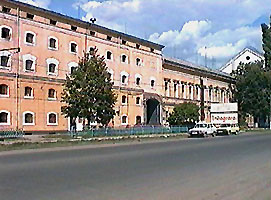 The economic structure did not change much after the union.
The heavy Industry continued to be represented by J. Weitzer's
fabric (that fusioned, in 1920, with the automobile producer
"Marta"), by the textile factory and the Mill of
the Neumann brothers and by the furniture fabric "Lengyel".
The famous liqueur plant "Zwack" also continued
production. The economic structure did not change much after the union.
The heavy Industry continued to be represented by J. Weitzer's
fabric (that fusioned, in 1920, with the automobile producer
"Marta"), by the textile factory and the Mill of
the Neumann brothers and by the furniture fabric "Lengyel".
The famous liqueur plant "Zwack" also continued
production.
New
fabrics added to the industrial activity, such as the Sugar
Plant (1926), "Polyrom" (varnishes and dyes, 1980),
The Technical Factory Arad (electric bulbs, 1935), "IRON"
(radios and electrotechnic appliances). Therefore, in 1937
existed 110 industrial units compared to 59 in 1919. The economic
crisis from 1929 - 1933 caused bankruptcy of many small industries
and concentrated the largest part of production in 22 major
companies.
The
commercial activity amplified, placing Arad with its 4001
trade companies on the fourth position in the country. Only
a small percent of these firms employed Romanian capital (8,7%
of the wholesale and 15 % of the retail companies).
The
banking system actively supported the local economic development.
Besides the local branch of the National Bank of Romania (opened
in 1921), ten other banks were active in the city. Among these
the "Victoria" Bank was representative for the Arad
finance.
The
quality of urban life is illustrated by the standard of the
services. The water works were rebuilt between 1931 and 1934
so the quality of the drinking water improved and the distribution
network expanded. The sewerage system also got modernised
with the assistance of British experts. Arad was one of the
first cities in Romania to be equipped with an automatic telephonic
exchange (1937).Urban transport improved after introducing
buses on 11 routes.
The
political life was bound to the fluctuations of the Bucharest
scene. Until the merging of the National Peasant Party from
the Old Kingdom (1926), the National Romanian Party represented
the interests of Transylvanians. After that the citizens of
Arad voted for the new created party and for the Liberals.
The Party of the Hungarians had a constant electorate. The
social-democratic parties had, somehow paradoxically, a minor
presence in Arad. At the elections from 1937, the last democratic
ones of the inter-war period, the preferences of the inhabitants
of Arad were oriented towards the extreme right party called
"Totul pentru Tara" (Everything for the Country),
followed by the Liberals and the Hungarian Party. The Royal
dictatorship put an end to parliamentary life in 1958.
The
international situation directly influenced the political
evolution in Romania. Despite the alliance with Germany, the
Romanian government wasn't able to prevent the loss of some
provinces including a large part of Transylvania (30 August
1940). The protests of the Romanians, including those from
Arad, weren't successful.
The
war gave Arad a hard time too. On top of the repeated restrictions
and requisitions added the Anglo-American bombings in July
1944, which wrecked military and civil buildings around rhe
railway station.
After
the policical coup in 23 August 1944, Arad got into the middle
of the battles between Romanian and the German-Hungarian armies.
On 22 September, the Hungarian troops withdrew from the city
after bowing up the bridges over the Mures, the railway station
and the telephonic exchange. In October and early November
1944, the Luftwaffe bombed the railway station causing important
damage.
After
the defeat of Hitler's Germany, Ist cavalry Division of the
Romanian Army returned to base in Arad being triumphantly
welcomed by the population (13 July 1945). Russian troops
were quartered in the Fortress.
Post-War
Arad
The
presence of the soviet army made it easy for the communists
to take over power in the city on 29 November 1944.
In
order to win the general elections from 1946, the communists,
supported by the soviet troops, used methods that defy democratic
society. Massive fraud allowed them to "win" the
elections in Arad and the entire country.
Once
the King abdicated the Romanian Popular Republic has been
proclaimed (30 December 1947) and the communist regime got
fully installed. Steps to enforce the soviet model followed:
the nationalisation of the main means of production (11 June
1948), the reorganisation of the teaching system (3 August
1948) etc. These were accompanied by the elimination, even
physical, of the political, economic and cultural elite.
In
Arad, the opposition of the terrorised civil society was rather
weak. One should, anyhow, mention the rebellion of the workers
from the Textile Plant, who, on 25 April 1947, killed the
secretary of their communist organisation. The brutal answer
of the authorities baffled any further resistance.
After
the soviet troops left, in 1958, a certain relaxation was
noticeable, which climaxed with the release of all political
prisoners. Taking over the power, in 1965, Ceausescu opened
the way to national- communism. Even if liberal, in a limited
degree, in the beginning, the regime ended with the Ceausescu
clan dictatorship.
Since
the entire public life was politicised, the decisions taken
by the centre were strictly applied in the territory. When
orders wherein obvious conflict with the interests of the
local community, mainly in the seventies and eighties, local
authorities assumed the risk of "softening" them.
These were individual gestures.
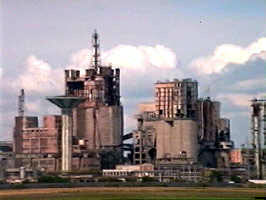 The first post-war years aimed to recover from the damage
caused by the war. In 1951 started the implementation of the
five-year plans and, meanwhile, the industrialisation. The
existing industrial units merged and were modernised. Afterwards
new units were built: the lathe machines factory (1949), "Aradeanca"
doll plant (1959), "Victoria" clock plant (1961),
the Chemical Fertiliser's Plant (1971) etc. The largest investments
in the fifties targeted the heavy industry, later they diversified,
but the giant factories of machine constructing industry still
swallowed the most important amounts of money. Despite the
massive investments, productivity remained low and most of
the products did not reach international standards. The first post-war years aimed to recover from the damage
caused by the war. In 1951 started the implementation of the
five-year plans and, meanwhile, the industrialisation. The
existing industrial units merged and were modernised. Afterwards
new units were built: the lathe machines factory (1949), "Aradeanca"
doll plant (1959), "Victoria" clock plant (1961),
the Chemical Fertiliser's Plant (1971) etc. The largest investments
in the fifties targeted the heavy industry, later they diversified,
but the giant factories of machine constructing industry still
swallowed the most important amounts of money. Despite the
massive investments, productivity remained low and most of
the products did not reach international standards.
Accelerated
development of industry was followed by a significant growth
of population. In the eighties Arad had over 150,000 inhabitants.
This demographic growth was accomplished mainly by encouraging
the village youth and inhabitants of the poor regions of the
country to move to the city, but also by radical steps like
prohibition for abortion and contraceptives, which increased
the birth race.
In
order to deal with the growing request of dwelling places,
new districts consisting of blocks of flats were built. The
commercial and service network was expanded. Remarkable was
the development of the tram rails network. With its 96 km
of railway, Arad reached the second place in the country,
after Bucharest. The problems seemed to be solved, only the
solutions were perfunctory, lacking quality.
The
investments of the seventies were possible because of massive
external credits. Ceausescu intended to pay the entire external
debt in the eighties. This was eventually accomplished by
sacrificing the needs of the population and forcing the existing
equipment to the limit. The citizens of Arad were affected
by the period of austerity, even if less than others.
The
events of December 1989 had an immediate echo in Arad where
a great number of people went out on the streets to express
their solidarity with the demonstrants in Timisoara. On 21
December, Arad became the second city in the country, after
Timisoara, where communist authorities were overthrown.
The Development
of Town Planning from the Beginning of the XVIIth Century
to the End of the XXth
The
inscalling of the Habsburg rule (1687) marks the beginning
of town planning in Arad. German colonists and the Serb frontier
guard troops essentially contributed to this. The maps drawn
by the middle of the XVIIIth century show four sectors of
the town: the fortress, the withdrawal region (retirade),
the "German town" and the "Serb town".
Evolution
of town planning stopped in second half of the century. There
are to major reasons to this: the Serb emigration to Russia
and, more important, the orders coming from Vienna that interdicted
any construction near the old fortress. After the new fortress
got into construction, beside the old interdiction a new problem
occurred: the Austrian authorities planned to move the whole
town to the Zimand Puszta. Vienna gave up the plan in 1781.
In
spite of this interdictions people continued to build houses
assuming the risks. The city expanded to the north, occupying
free land, as well as to the south were new construction space
was created after the Austrian demolished the old fortress.
As the future centre of the town the actual Avram Iancu Place
took shape. Here stood the town hall, which has been repaired
and enlarged in 1770. The census from 1783 registered 84 streets
to which the one from 1797 added the Forum Venalicum Piscium.
This Fish Market was an extension to the north of the old
commercial street Tribunul Axente.
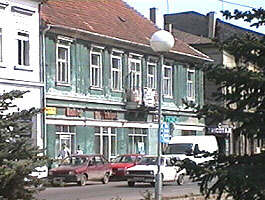 After the new fortress got ready and occupied by the army,
authorities set a 2 km security area around it in which no
constructions could be build and the existing ones had to
be demolished. But constructions continued to appear. Among
those who assumed the risk was the rich merchant Jacob Hirschl,
who, in 1817, built a theatre along with his own house (today
on Gh. Lazar Str. 1 - 3). In 1818 the military authorities
reduced the security area to 500 m, giving satisfaction to
the demands of the city inhabitants. New perspectives were
opened to town planning, which in 1828 centred the future
evolution of the city on the Avram Iancu Place. After the new fortress got ready and occupied by the army,
authorities set a 2 km security area around it in which no
constructions could be build and the existing ones had to
be demolished. But constructions continued to appear. Among
those who assumed the risk was the rich merchant Jacob Hirschl,
who, in 1817, built a theatre along with his own house (today
on Gh. Lazar Str. 1 - 3). In 1818 the military authorities
reduced the security area to 500 m, giving satisfaction to
the demands of the city inhabitants. New perspectives were
opened to town planning, which in 1828 centred the future
evolution of the city on the Avram Iancu Place.
The
construction rhythm fastened up after Arad became a Free Royal
Town. New street fronts were opened (see Metianu Str.) and
the old ones were refreshed with new buildings, such as the
hotel "White Cross" (1841).
The
flood from 1844 and the bombings during the '48 revolution
caused important damage. In the spaces created by demolishing,
new and representative buildings were risen.
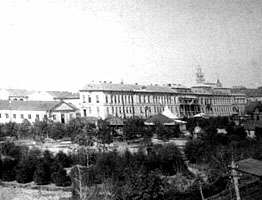 The railway station, opened in 1858, set the northern point
to the central axis of the town. During the last decades of
the XIXth century and the beginning of the XXth, along this
central axis the most representative constructions of the
city were built: the theatre (1874), the town hall (1876),
the Finance Palace (1885), the Cenad Palace (1887), the Neumann
Palace (1902), the building of the National Bank (1912), the
Cultural Palace (1913) etc. The new buildings and the renovations
realised around the year 1900 are strongly marked by the Secession
style. The railway station, opened in 1858, set the northern point
to the central axis of the town. During the last decades of
the XIXth century and the beginning of the XXth, along this
central axis the most representative constructions of the
city were built: the theatre (1874), the town hall (1876),
the Finance Palace (1885), the Cenad Palace (1887), the Neumann
Palace (1902), the building of the National Bank (1912), the
Cultural Palace (1913) etc. The new buildings and the renovations
realised around the year 1900 are strongly marked by the Secession
style.
During
the inter-war period residential districts have been built,
in concordance with the new conception of the garden towns.
On the central axis the residence of the Social Assurance
House was built.
During
the communist regime the huge block districts like Micalaca,
Aurel Vlaicu and Alfa were built. They are the same in all
cities of the country. In the central area some huge buildings
have been inserted: the hotel "Astoria", the block
with the "Dacia" cinema, the "Ziridava"
shopping centre.
The Spiritual
Life
The
religious life is tightly bound to history of Arad, right
from its beginning.
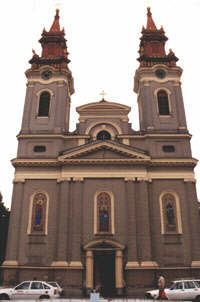 The Orthodox Church on the territory has its roots in the
XVth century, according to tradition. In the first half of
the XVIIIth century two orthodox communities - Romanian and
Serb - grouped by the two churches "St. Apostles Peter
and Paul", in the "Serb Town", and "St.
John the Baptist", on the place of today's "Moise
Nicoara" high school. The number of faithful grew up
to 5595, in 1770, so a larger church was needed. In 1791 Bishop
Pavel Avacumovici ordered the building of a new house of worship
on the place of the old "St. John the Baptist" church.
Heavy bombings during the '48 revolution did important damage
to the new church so the Imperial authorities ordered it to
be demolished. A new cathedral was built between 1861 and
1870 on the eastern side of the Big Market. The cathedral
gathered a pleiad of Romanian intellectuals actively involved
in the Romanian emancipation movement. The Orthodox Church on the territory has its roots in the
XVth century, according to tradition. In the first half of
the XVIIIth century two orthodox communities - Romanian and
Serb - grouped by the two churches "St. Apostles Peter
and Paul", in the "Serb Town", and "St.
John the Baptist", on the place of today's "Moise
Nicoara" high school. The number of faithful grew up
to 5595, in 1770, so a larger church was needed. In 1791 Bishop
Pavel Avacumovici ordered the building of a new house of worship
on the place of the old "St. John the Baptist" church.
Heavy bombings during the '48 revolution did important damage
to the new church so the Imperial authorities ordered it to
be demolished. A new cathedral was built between 1861 and
1870 on the eastern side of the Big Market. The cathedral
gathered a pleiad of Romanian intellectuals actively involved
in the Romanian emancipation movement.
The
Romanian Orthodox Metropolitan of Transylvania was reactivated
in 1865. The Bishopric of Arad was annexed to it and liberated
thus from under the authority of the Serb Church. Orthodox
Churches were built in the districts and the suburbs of Arad
depending on the number of parishioners and their economic
power: Micalaca (church in the XVIIIth century; a new one
in 1845), Vladimirescu (1930), Sega (1933), Gradiste (1940),
Micalaca Noua (1944), Bujac (1976), Gai (1936), Aradul Nou
(church in the XVIIth century; a new one in 1937), Sanicolau
Mic (church at the beginning of the XVIIIth century; a new
one in 1804).
Since
1934 the community considered building a cathedral on the
main axis of the city but various reasons delayed this project
until 1994.
The
Orthodox Church had an important contribution in maintaining
the Romanian national identity and was very active in preparing
the Union. In the years of the communist regime, its position
was delicate, therefore unfortunate compromises and brave
actions joined in its attitude.
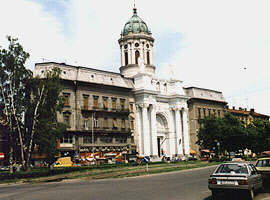 The Catholic Church started its activity in Arad by the
end of the XVIIth century, when Franciscan (Minorit) priests
arrived in Arad together with the Austrian army. They served
both in the fortress and in the civil settlement where they
contributed to the construction of the first Catholic Church
by the beginning of the XVIIIth century. This was replaced
with a larger one in 1758. Between 1902 and 1904 a commanding
cathedral was built on the place of the old church. Catholic
parishes exist in the discricts Gradiste, Sega, Aradul Nou
and Gai. The Catholic Church started its activity in Arad by the
end of the XVIIth century, when Franciscan (Minorit) priests
arrived in Arad together with the Austrian army. They served
both in the fortress and in the civil settlement where they
contributed to the construction of the first Catholic Church
by the beginning of the XVIIIth century. This was replaced
with a larger one in 1758. Between 1902 and 1904 a commanding
cathedral was built on the place of the old church. Catholic
parishes exist in the discricts Gradiste, Sega, Aradul Nou
and Gai.
The
Greek-Catholic Church settled in Arad around 1770 and from
1776 on had its first house of worship. A new church was built
between 1912 and 1915 and another construction started in
the inter-war period in Sega.
In
1948, the communist regime abolished the Greek-Catholic Church
and the ownership of the churches passed to the Orthodox cult.
In 1991 the Greek-Catholic parish was restored.
The
Reformed Church is first attested in Arad in the XVIth century
but don't know anything about their houses of worship until
the XIXth century when the still standing church was built
(1852). Reformed parishes exist in Gai and Gradiste.
The
Evangelic-Lutheran Church exists in Arad since the first half
of the XIXth century. The growth of the community and their
financial potential required the building of an adequate church
so in 1906 they had the new "Red Church".
The
Neo-Protestant Church found adherents in Arad at the end of
the XIXth century. The first was the Baptist community that
its own house of worship in Micalaca in 1897 (today there
are 17 Baptist churches in Arad). At the beginning of the
XXth century, the Adventist and the Pentecostal communities
stepped into life.
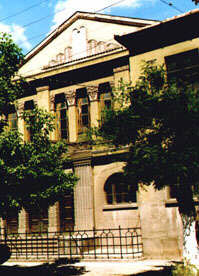 The Mosaic cult
became an important component of the religious life of the
town during the first half of the XVIIIth century. The Jews
settled in the eastern part of the "Serb Town" after
the frontier guardians left. An expression of the wealth of
the community is the complex of buildings with the synagogue
in its centre, finished in 1834. On spiritual level, the community
is renowned first through the outstanding activity of the
Rabbi Chorin Aaron reformers of the Mosaic cult. The Mosaic cult
became an important component of the religious life of the
town during the first half of the XVIIIth century. The Jews
settled in the eastern part of the "Serb Town" after
the frontier guardians left. An expression of the wealth of
the community is the complex of buildings with the synagogue
in its centre, finished in 1834. On spiritual level, the community
is renowned first through the outstanding activity of the
Rabbi Chorin Aaron reformers of the Mosaic cult.
Education
began within the church. The Minorit monks founded the first
school in 1715. The teaching language was German. During the
following five years another three schools were created: two
orthodox and a catholic one with teaching in Hungarian. Education
was supported by the church through the religious communities
and by the Town Council. The first secondary school was organised
in 1753 by nuns from Notre Dame. A Latin school functioned
since 1745. The education system got a new organisation through
the laws from 1774.
The
Foundation of the "Preparandia", in 1812, was of
major importance for the cultural and political emancipation
of the Romanians. The school prepared Romanian teachers.
 The new Law of Education From 1868 permitted religious
communities, public associations and the state to ground schools.
Arad had four Romanian schools (in 1873), besides the "Preparandia"
(Arad - city, in Micalaca, Parneava, Sega), 11 Hungarian (in
the years 1884/1885), one Serb (from 1792 on) and one Jewish
(from 1832 on). The Budapest government introduced Hungarian
as an obligatory class in all schools (1883), and later gave
it a privileged status (1907). The new Law of Education From 1868 permitted religious
communities, public associations and the state to ground schools.
Arad had four Romanian schools (in 1873), besides the "Preparandia"
(Arad - city, in Micalaca, Parneava, Sega), 11 Hungarian (in
the years 1884/1885), one Serb (from 1792 on) and one Jewish
(from 1832 on). The Budapest government introduced Hungarian
as an obligatory class in all schools (1883), and later gave
it a privileged status (1907).
Between
the world wars the educational system was exclusive state
matter. The first Romanian high schools of the town, "Moise
Nicoara" and "Elena Ghiba Birta" were grounded
in 1919.
After
World War II the communist rule organised the educational
system after the soviet model. The only college was the one
for veterinarians, founded in 1948 and moved to Timisoara
in 1956. Only since 1990 Arad has its own universities: "Aurel
Vlaicu" (state) and "Vasile Goldis" (private).
In
the years of the communist regime, Arad had 33 primary and
secondary, 22 high schools, l3 technical schools and 6 post
high school institutions. Though the teaching process was
strongly dominated by politics, the schools from Arad gained
recognition for the serious training of their pupil.
Theatre
representations started in 1787, according to written evidence.
At that time the German ensemble lead by Philip Berndt opened
its season at Arad. But this couldn't have been the first
representation. According to a street register from 1783 there
existed a "Theatergasse" (Theatre Street) leading
to the "Arena" of Sava Thokoly.
The
effective theatre movement began in the autumn of 1817 as
the theatre build by Jacob Hirschl opened its doors. On this
scene numerous German, Hungarian and Romanian ensembles played
along the years.
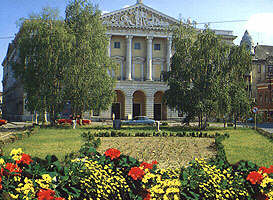 The new theatre
building has been opened in 1874 but it had to be almost totally
rebuilt after the great fire of 1883. Until 1945 its repertoire
consisted just of Hungarian spoken plays. In the year 1948
the still existing State Theatre was founded. The new theatre
building has been opened in 1874 but it had to be almost totally
rebuilt after the great fire of 1883. Until 1945 its repertoire
consisted just of Hungarian spoken plays. In the year 1948
the still existing State Theatre was founded.
The
musical life of the city was marked for over a century by
the Conservatorium. As it was founded, in 1833, it was the
sixth institution of this kind in Europe. Until 1948, as its
activity was stopped, the Conservatorium trained numerous
fine instrumentalists and formed the musical taste of the
city inhabitants. The quality of both, the orchestra and the
public, determined various important artists and composers
to play in Arad: Franz Liszt (1846), Johann Strauss Jr. (1847),
Pablo Sarasate (1877), Henryk Wienawski (1877), George Enescu
(1922 and in the following years) and Bela Bartok (1924).
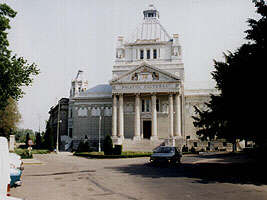 The still existing
State Philarmony Arad was founded in 1948. The still existing
State Philarmony Arad was founded in 1948.
Literature
has been written in Romanian only after the founding of the
"Preparandia". In 1857 the first reader's union
of the pupil started its activity and two years later succeeded
in issuing the Almanac "Muguri"under the redaction
of M. V. Stanescu.
The
"National Association from Arad for the Culture and Conversation
of the Romanian People", created in 1862, organised various
conferences on literary themes.
In
the period 1871 - 1918 a large number of reviews with literary
content were issued in Arad: "Gura Satului "(first
issue l871), "Lumina"(1871), "Biserica si Scoala"(1877),
"Tribuna Poporului" (1896), "Tribuna"(1904),
"Romanul"(1911). These published Romanian writers
from Arad, such as I. Slavici, A. Cotrus, M. Nicoara, Al.
Gavra, M. V. Stanescu, A. M. Marienescu, N. Oncu, I. Grozescu,
R. Ciorogariu, as well as major authors of Romanian literature:
V. Alecsandri, Al. Macedonski, Gr. Alexandrescu, G. Cosbuc,
I.L. Caragiale, M. Sadoveanu, L. Blaga and others.
Among
the authors who wrote in other languages than Romanian one
should cite the Hungarian playwright Csiky Gergely and the
German writer Adam Miiller Guttenbrunn.
A remarkable
editorial activity was done by the "Biblioteca Semanatorul",
which published 1984 volumes of Romanian literature in the
period 1926 - 1927.
In-between
the two world wars about 70 cultural associations were registered
in Arad. The most important among these were: "The National
Association ...", which in 1924 united with the ASTRA,
"Concordia"(founded in 1910) and "Ateneul Popular"(1931).
The literary reviews were represented by "Solidaritatea"(first
issue 1922), "Tribuna Aradului"(1925), "Vointa
Poporului"(1923), "Tribuna Noua"(1924), "Salonul
Literar"(1925), "Hotarul"(1933), "Bravo!"and
"Innoirea"(1937).The most important authors of the
local literary scene were Al. T. Stamatiad, F. Munteanu, M.
Micu, Gh. Achitei, D. Rachici, D. Ureche and R. Muresanu.
After
1947 the communist regime tried, and partially succeeded,
to subordinate literature also. The Arad branch of the Romanian
Writers' Association was created in 1948. The two journals
issued in Arad during the communist regime, "Flacara
Rosie"and "Voros Lobogo", published in their
literary supplements authentic literature too. Between 1968
and 1989 several collective literary volumes were issued.
Most of the important authors from Arad can be found in the
pages of these.
Among
the most important writers of the period one should cite,
from Arad: St. Augustin Doinas, Gh. Schwartz, Fl. Banescu,
R. Bucur, V. Gheorghita, V. Dan, D. Sibii and H. Ungureanu.
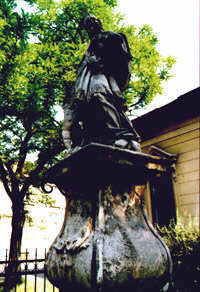 Fine arts developed in Arad only after the installation
of the habsburgic regime. The monument we know of is the statue
of Saint Nepomuk (1729). Fine arts developed in Arad only after the installation
of the habsburgic regime. The monument we know of is the statue
of Saint Nepomuk (1729).
In
the second half of the XVlllth century the town had its own
artistic life illustrated by the painter family Osztermayer
and by Stefan Tenetchi who painted most of the important Orthodox
Cathedrals from the Banat, including the ones from Arad.
During
the XIXth century several Austrian and Hungarian painters
settled in Arad. They were exponents of the academism such
as J. Geltz, D. Jagermann, Emeric and Adalbert Vizkeleti,
E. Szamossy and P. Bohm. Major Hungarian painters started
their career in Arad - M. Munkacsy and L. Paal.
1n
the period between the two world wars C. Wolf, I. Stern, C.
Kiss, and F. Balla continued to paint in the old academic
style. I. Toader, C. Minisan, Al. Pataki and V. Anyos succeeded
to get beyond the barriers. A new spirit was brought to Arad
by the sculptors R. Ladea, Gh. Groza and M. Olinescu, who
founded the "Pro Arte"group in 1936.
Under
the communist regime artists were put in front of the dilemma
weather to obey the official line of the "socialist realism"and
get the recognition of the Party, or to follow their own way
risking difficult situations. Most artists assumed the second
option. The major artists of Arad during this period were
N. Chirilovici, S. Frentiu, F. Baranyai, E. Vitroel, Lia and
Ioan Cott, I. Tolan, Sc. Gules, E.S. Muntean, N. Bicfalvi,
P. Alaszu, L. Babocsik, O. Colta, L. Josan Kocsis, I. Kett
Groza, A. Strasnei Popa, Z. Eisele Sucs, M. Tamas, D. Serban,
I. Stroia, L. Cociuba and M. Pacurar.
The
press appeared in Arad at the beginning of the XIXth century.
The "Arader Kundschaftsblatt", first issued in 1837,
represents the start. In 1840 its Hungarian alternative followed
- "Aradi Hirdeto".
The
oldest daily newspaper is the "Alfold", first issued
in 1861, followed by "Aradi Kozlony" (1885 - 1940).
The
Romanian press got started in the clerical milieu. The first
review was "Speranta", issued between 1869 - 1872.
The most appreciated and long lasting Romanian review was
the one called "Biserica si Scoala" edited between
1877 and 1948. Resuming, one can find out that until 1918
in Arad 28 papers were issued, a number that increased to
108 in the interbelic period.
Under
the communist regime two daily papers were issued in the town
- "Flacara Rosie" and "Voros Lobogo".
Sports
and Places of Leisure
Arad
is the cradle of Romanian football. The first official game
took place in 1899. Afterwards numerous sport clubs organised
football sections. The most famous is UTA, which since 1946
has its own stadium financed by F. Neumann, the same who sponsored
the football team.
The
sporting clubs from Arad obtained remarkable results in table
tennis, basket, boating, target shooting and gymnastics.
The
most important place of leisure is the "Neptun"
area, which includes several swimming pools, bars, restaurants,
discos, open air scenes and so forth, all located on the left
bank of the Mures, close to the fortress. The whole area was
arranged in 1970 and is constantly updated.
|
